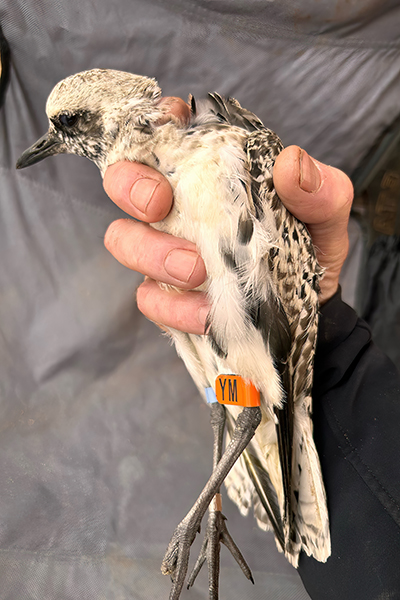We made it back to Altcar Army base to canon net and flag waders as part of an on going study. A previously planned attempt was cancelled as the gods of wind and rain combined to create a high tidal surge which meant there was no beach for the waders to roost on! This time, however, the conditions were almost ideal. An offshore wind combined with a hight tide and reports of plenty of birds roosting on site.
Arriving at the base with Chris we soon signed in and waited for the rest of the team to assemble before driving to the site where we set 4 canon nets. From then on it was a waiting game with a small team of 'lifters' lying quietly in the dunes just behind the nets so we could get there quickly and start lifting when and if the canons were fired. The rest of the team would drive down from the car park where spotters were keeping an eye on the birds moments around the nets to make sure we were safe to fire
All great in theory if the birds play ball. We could hear birds coming into roost all round us and at one pount had a good number in the catching area but it wasn't safe to fire as there were birds in the air above the net. Still we waited - then a Sparrowhawk flew through and put everything up! The birds were jittery and and started dispersing so people were dispatched to try and 'twinkle' them back along the beach. Finally on a falling tide a catch was made. I didn't hear the canons fire as I'd been dispatched further dow nthe beach to try and twinkle birds along. Wearing fleece line trousers and chest waders I jogged down the dunes for 20 minutes before emerging on the beach and gradually working my way north again. I didn't have any radio reception and couldn't raise any one on the phone but I guess my mission was successful as when Chris did ring me he told me the team had made a good catch. I reckon I lost 3-4 kg in sweat!
When I eventually arrived back at the catching site I found a very happy team! A good catch had been made of the target species - Knot and Grey Plover - meaning a meaningful sample could be flagged. We also caught good numbers of Dunlin and Sanderling.
Provisional totals from Richard were:
Grey Plover. New 29. Retrap 1
Ringed 2019 ~35 sightings since ringing, all around Altcar
Hopefully there will be as many sightings of these birds as ones we've previously flagged and the data will provide us with more information about their migrations and stop-over points to aid with their conservation.











































































